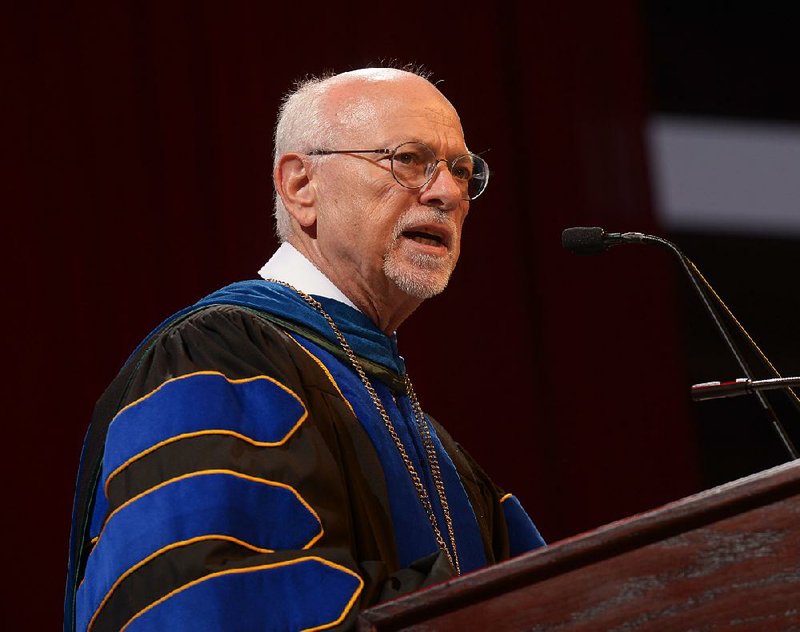FAYETTEVILLE -- At the "very top of the list" for future building projects at the University of Arkansas, Fayetteville are a center for tutoring and other student support and a research facility, Chancellor Joe Steinmetz said Thursday.
Steinmetz touted a record-high student retention rate and an increase in research funding during an annual address that also touched on the school's recent drop in U.S. News & World Report rankings.
In response to a question about facilities, Steinmetz described his priorities.
"In my mind there are two major capital projects that are at the very top of the list. One of them is a student success center," Steinmetz said. Fundraising is bringing the project closer to "becoming a reality," he said.
The University of Arkansas board of trustees in March approved the project, which is expected to cost $40 million to $45 million.
Plans for the building include space for tutoring, personal mentoring and food service, UA officials have said. Portions of a $26.9 million bond issue will go toward financing the project, according to an official statement accompanying the bonds.
"The second piece is we need a major research building as well," Steinmetz said. He said that earlier in the day he had spoken with Provost Jim Coleman about forming a group "to begin the discussions of what that research building looks like."
In his prepared remarks, Steinmetz said federal research expenditures for UA increased last year to more than $52 million, up from $46.4 million.
Plans for boosting research include possibly creating a new source of university support, similar to the existing Chancellor's Innovation and Collaboration Fund, that would help projects "with a high potential for commercialization," Steinmetz said.
UA had a 1.6 percentage point increase in its most recent freshman retention rate, totaling 83.8 percent, an all-time high, Steinmetz said. The university, in data published online, reported having 5,065 first-time, degree-seeking freshmen in fall 2017.
The increase in retention "might sound modest," Steinmetz said, "but if you step back and say how many students does that translate to, it's a little over 80 students more. We estimate that those 80 students will actually pay about $950,000 in tuition."
He said that "much more important than the dollars" is that this increased retention should result in more students earning degrees.
Steinmetz said that since his arrival, he's held that UA is not going to chase after rankings, especially those "that reward us simply for admitting students with high ACT scores."
"Instead, we're going to keep focused on the things that matter. That's retaining and graduating students, serving first-generation and diverse students, growing our scholarship base and increasing our access. These are the things that matter at the University of Arkansas," Steinmetz said.
UA dropped 15 slots to 78th among 132 public universities in the most recent U.S. News & World Report ranking of national universities, a slide that Steinmetz said reflected a change in the how the rankings are calculated.
U.S. News & World Report took into consideration the graduation rates of students receiving Pell grants, federal aid for students with exceptional financial need.
Steinmetz said the six-year graduation rate for students receiving Pell grants who entered UA in 2011 was about 45 percent, which he said was "unusually low."
A UA graduation report published online sorts Pell grant recipients into two groups: those receiving both Pell grants and Stafford loans and those getting Pell grants but not Stafford loans.
The 705-student 2011 group receiving both Pell grants and Stafford loans had a six-year graduation rate of 42.3 percent, a drop compared with the graduation rates of 45.7 percent for the 2010 group, which consisted of 505 students, and the 45 percent rate for the 2009 group made up of 318 students.
For students receiving Pell grants but not a Stafford loan, the UA report listed a six-year graduation rate of 51.3 percent for the 304-student 2011 group. This rate dropped compared with the 59.2 percent graduation rate for the similar 2010 group, which consisted of 388 students, and the 57.4 graduation rate for the 2009 group, made up of 242 students.
"I don't believe there's reason to be alarmed" at the rankings drop, Steinmetz said, stating that the latest numbers have shown a boost in graduation rates.
Last month, UA reported for all students a record 65.5 percent six-year graduation rate, a number calculated based on a group of 4,546 students who entered school in 2012, with some additional students excluded for reasons including military service or death.
Metro on 10/05/2018

